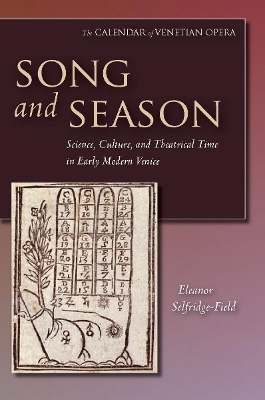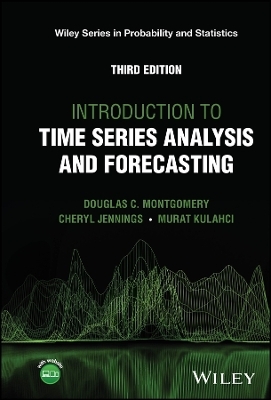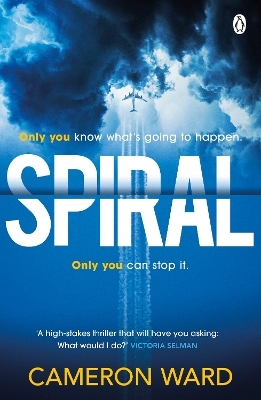
Song and Season
Stanford University Press (Verlag)
978-0-8047-5765-2 (ISBN)
Two systems of timekeeping were in concurrent use in Venice between 1582 and 1797. Government documents conformed to the Venetian year (beginning 1 March), church documents to the papal year (from 1 January). Song and Season defines the many ways in which time was discussed, resolving a long-standing fuzziness imposed on studies of personnel, institutions, and cultural dynamics by dating conflicts. It is in this context that the standardization of timekeeping coincided with the collapse of the dramma per musica and the rise of scripted comedy and the opera buffa. Selfridge-Field discloses fascinating relationships between the musical stage and the cultures it served, such as the residues of medieval liturgical feasts embedded in the theatrical year. Such associations were transmuted into lingering seasonal associations with specific dramatic genres. Interactions between culture and chronology thus operated on both general and specific levels. Both are fundamental to understanding theatrical dynamics of the sixteenth to eighteenth centuries.
Eleanor Selfridge-Field is Consulting Professor of Music and Co-Director of the Center for Computer-Assisted Research in the Humanities at Stanford University. She is the author of many books and articles in various fields, including Beyond MIDI (1997); The Music of Benedetto and Alessandro Marcello (1990); and Venetian Instrumental Music from Gabrieli to Vivaldi (1975).
Contents Illustrations Figures Tables Abbreviations and Citations Preface 8 9 10 12 15 Part One. Marking Time I. Venice's Years 1.1. Christendom's Year 1.2. The Liturgical Year 1.3. The Ducal Year 104. The Accounting Year 1.5. The Academic Year 1.6. The Virtual Year 21 22 29 32 34 35 36 38 38 45 46 46 49 50 50 2. Calendrical Markers and Their Cultural Foundations 2.1. Civic Markers 2.2. Liturgical Markers 2.3. Actuarial Markers 204. Rites of Political Passage 2.5. Civic and Diplomatic Feasts 2.6. Ducal Feasts 2.7. Double Feasts 3. Venice's Days and Hours 3.1. The Mobile Day 3.2. Civic Clocks 54 54 56 4 SONG AND SEASON 3.3. Religious Hours 304. Solar Time 3.5. Civic Bells 3.6. Bell-ringing Schedules 3.7. Hour- Glass Time 3.8. Workers' and Artisans' Bells 3.9. Timekeeping Reforms 3.10. The Emergence of Modern Timekeeping 3.11. Modern Equivalents for Venetian Time 3.12. Post-Republican Time Part Two. Using Time 4. Theatrical Culture and Theatrical Time 4.1. Commedia and Theatrical Culture 4.2. Gambling and the Theater 4.3. Government Constraints on Productions 404. Economic Change and the Theater 4.5. Patronage Models and Practices 4.6. First, Last, and Ordinary Nights 4.7. Carnival as a State of Mind 4.8. Carnival as a Time of Year 4.9. Masking by the Hour 4.10. Pseudo-Carnival Days 4.11. Dating to the Day 5. Theatrical Periods and Seasons 5.1. A Composite Model of the Theatrical Year 5.2. Autumn Autumn as a Comedy Season (119); Autumn as an Opera Season (120); The St. Luke's Period (120); The St. Martin's Period (121) 5.3. Advent The St. Andrew's Period (124); The Novena of Christmas (125) 59 62 63 65 69 72 74 78 80 83 87 87 93 98 101 102 105 106 107 109 III 112 115 115 119 124 SONG AND SEASON 504. Winter The St. Stephen's Period (127); Carnival (132); Fat Week (134); Last Nights of Carnival (136); Last-Night Theatrical Banquets and Balls (137); Last "Days" vs. Last "Nights" (140) 5.5. Spring 5.6. Ternporal Dimensions of Productions 5.7. External Proofs of the Composite Model 6. Theatrical Specialization by Period 6.1. San Cassiano 6.2. SS. Giovanni e Paolo 6.3. San Moise 604. San Salvatore 6.5. San!' Angelo 6.6. San Giovanni Grisostomo 6.7. Piazzola 6.8. San Samuele 6.9. San Fantin and Other Small Theaters 6.10. San Benedetto and the Teatro La Fenice 6.11. Composite Production Profiles 7. Seasonal Reciprocity 7.1. Opera for Provincial Fairs Autumn Venues (181); Spring Venues (188) 7.2. Dramatic Music in Private Venues Solo Motets (195); Oratorios (196); Cantatas (197); Serenatas (198); Private Concerts (199); Rehearsals (200); Contributions by Amateurs (200) 7.3. Dramatic Music in Non-Theatrical Periods Advent and the Novena of Christmas (20 I); Lent (202); Eastertide (203); The St. Anthony's Period (204); The Assumption Period (205); Autumn Villeggiatura (205) 8. Season and Genre 8.1. Venice as a Metaphorical Stage 8.2. Opera as Commedia 5 126 143 148 149 151 152 156 157 158 160 162 166 168 169 173 174 176 176 195 201 206 206 209 6 SONG AND SEASON 8.3. Comedy, Tragedy, and Arcadian Reforms The Reform of the Dramma per musica (210); The Revival of the Classical Tragedia (211); The Grimani vs. the Vendramin (213); Effects of the Grimani-Vendramin Contracts (219) 804. Transitions and Gestations Comedies with Music; Imer and Gori (220); The Reform of Comedy: Carlo Goldoni (223); Other Contributions to the Opera buffa (228); Reactions to the Opera buffa (229) 8.5. Seasonal Dimensions of Genre Conflicts Ambiguities of Spring Opera (234); Historical Dimensions of Genre Change (235) 9. Season and Genre from the Middle Ages to Today 9.1. Medieval Models 9.2. Italy frorn 1660 to 1760 Florence (238); Naples (240) 9.3. Europe from 1660 to 1760 Paris (241); Dresden (243) 904. Europe after 1760 Opera Calendars under the French (246); Opera Calendars under the Austrians (248); Lenten Opera in Vienna (254) 9.5. The Calendar of Venetian Opera at Large 9.6. Seasonal Models Today Part Three. Telling Time 10. Time According to the Eagles 10.1. The Eagles and the Moles 10.2. Cultural Artifacts and Temporal Order Literary Artifacts (269); Musical Artifacts (271) 10.3. The Eagles and their "Chronologies" Ivanovich (276); Bonlini (278); Groppo (283); Rossi (290); Galvani (292); Wiel (293); Aim (295) 1004. Time in Genre Surveys Opera Surveys (298); Theater and Drama Studies (300); Chronologies for other Locales (301); Work Dates in Music Encyclopedias (30 I) 10.5. Time, Genre, and Chronology 210 220 232 237 237 238 241 245 256 262 267 267 267 276 298 302 SONG AND SEASON II. The Chronicles of the Moles 11.1. The Post and the News 11.2. Censorship and the News 11.3. Weekly News from Venice Awisi from Venice (313); The Pallade veneta Manuscripts (315); The Mercuri (315); Reports of the Papal Legate (316); Avvisi sent with Diplomatic Reports (317) 1104. Weekly News Aggregations Bologna (318); The Corriere ordinario (Vienna) (318); The Diario ordinario (Rome) (319) 11.5. Monthly News Aggregations Le Mercure galanl (320); La Ga eta de Madrid (321); Pallade veneta (321); News Translations (322); Post- Republican News (324) 11.6. Theatrical News in Government Records Diplomats' Records (325); Spies' Records (327); Censors' Records (330); Notaries' Records (332); Other Sources for Chronology (333) 11.7. Indigenous Theatrical Moles Goldoni as Consul (335); Rousseau as Ambassadorial Secretary (335); Casanova as Government Informer (336) 11.8. From Chronicles to Dates Dispatch Dates (33); RectifYing Dates from the Moles (338); Error Rates for the Eagles (344) 12. New Times, New Tellers 12.1. New Times 12.2. New Tellers Pietro Gradenigo (348); Gasparo Gozzi (349) 12.3. The Polemics of Genre 1204. The Polemics of Cultural Time 12.5. The Enduring Theatrical Calendar Sources Cited General Index Index of Musical Works 7 304 306 311 312 317 319 325 334 337 346 346 347 351 354 356 359 375 391 Illustrations 1.1. Mnemonic hand for decoding the calendar (1705) 3.1. Detail from Francesco Guardi's painting II Torre del Orologio 3.2. The San Marco clock (Orologio) before its latest restoration 3.3. The clock and bells of San Giacomo di Rialto 304. The bell-ringing schedule adopted in 1752 3.5. Goethe's conversion table for German and Italian time (1786) 6.1. Map of Venice (1804) showing location of theaters 6.2. Garden in which the former San Cassiano was located 8.1. An agreement signed by G C. Grimani and A. Vendramin 10.1. Sample title-pages and dedications from opera libretti 10.2. Pages from Bonlini's printed Le g/orie della poesia (1725- 26) 10.3. Unbound aggiunle (1734) to the Bonlini catalogue 1004. Pages from Groppo's Cala/ogo (1725-26) 10.5. Title leaf from the 1745 holograph ofGroppo's Cala/ogo II.I. Opera commentary in Le Mercure ga/anl (1679) 11.2. Opera commentary in Pallade venela (1687) 30 58 60 61 64 77 153 154 218 272 280 281 285 286 320 322 Figures 3.1. The "fish" silhouette of light and dark hours 5.1. Schematic view of theatrical periods in an average year 5.2. The "S!. Stephen's effect" on opening dates for operas 6.1. Distribution of opera productions at San Cassiano 6.2. Distribution of opera productions at SS. Giovanni e Paolo 6.3. Distribution of opera productions at San Moise 604. Distribution of opera productions at San Salvatore 6.5. Distribution of opera productions at Sant' Angelo. 6.6. Distribution of opera productions at San Giovanni Grisostomo 6.7. Distribution of opera productions at San Samuele 9.1. Drammi per musica given in Florence (1670-1750) 9.2. Operas given in Paris (1673 and 1749) 10.1. Schematic view of title-page and dedication dates 10.2. Number of works survived by musical materials 11.1. Schematic facsimiles of a libretto title-page and dedication 63 117 127 155 157 158 159 161 163 169 239 242 270 274 339 Tables 1.1. The Venetian school year in the eighteenth century 1.2. Virtual definitions of the year in order of initiation 2.1. Principal bodics of the Venetian government 2.2. A composite view of sacred and secular fixed feasts 3.1. Names and functions of the Campanile bells 3.2. Principal times for bell-ringing (12th-14th centurics) 3.3. Comparison of bell nomenclatures 304. Bells for workdays and feast days 3.5. Times at which the Realtina rang during autumn and winter 3.6. Hours for ringing the morning lerza (1752) 3.7. Hours of assembly and dismissal, University of Padua (1788) 3.8. Hours for sunrise and the ringing of the lerza (1782, 1860) 4.1. Quarterly closure dates for the civic lottery bank 4.2. Liturgical and civic dating alternatives for feast days 5.1. Divisions of the accounting year into theatrical periods 5.2. The order in which theatrical periods evolved 5.3. Conflicting times of performance for Adriano in Siria 6.1. Average number of works per theater per year 7.1. Provincial dates of adoption of individual theatrical periods 7.2. Autumn works given in Rovigo 7.3. Autumn works given in Dolo 7 A. Autumn works given in Este 7.5. Autumn works given in Treviso 7.6. Spring works given in Vicenza 7.7. Winter works given in Vicenza 7.8. Spring works given elsewhere in the Veneto 7.9. The sequence of ceremonial events on 24-26 December 36 36 48 51 66 67 68 70 73 76 80 81 97 114 116 118 140 174 180 182 186 186 188 190 191 193 202 SONG AND SEASON II 8.1. Genre specialization by theater and season 8.2. Genre preference by theatrical period 9.1. Significant premieres given during Lent 9.2. Selected works opening during the St. Luke's period. 9.3. Selected works opening during the St. Martin's period. 904. Selected works opening during the St. Stephen's period 9.5. Selected works opening during Carnival 9.6. Selected works opening during the Ascension period 9.7. Selected works opening during the summer 10.1. Principal bibliographies of Venetian opera. 11.1. Delivery and departure times for the post 11.2. Comparison of dates for works of the 1670s and 1680s 11.3. Comparison of dates for works of the 1720s to 1740s 1104. Canvas of dates for works of the 1690s and l700s 11.5. Year- and sequence-error rates for bibliographies 231 233 255 257 257 259 260 261 262 296 308 341 341 342 344 Abbreviations and Citations Text abbreviations in primary sources (e.g. in "ill.mo") in printed citations are expanded with italicized letters (e.g., iIIuslrissimo). Document quotations retain their original spelling. Archaic capital letters have been changed to lower case. Punctuation is unchanged apart from the occasional addition ofa period (.). Most documents cited are not quoted in the original, since eventual publication of all documentation is intended. Dates are given literally (as found). Time and culture: M.V. more veneto: the Venetian calendar date [January and February belong with preceding year] ore venele: time as computed by the Venetian method. The new day began at a variable time which was nominally 30 minutes after sunset. Time was recorded in the 24- hour style. O.v. Early news-sheets and archival series: I A Awisi: weekly MSS [see under diverse sigla below] AG Archivio Gonzaga: a general division of I-MAas AS Archivio Segreto: a general division ofl-Rvat BG Bologna: printed gazettes in I-Bag CO II corriere ordinario: printed weekly gazettes in A. Wn CX Capi, Consiglio dei Dieci: series in I-Vas DO Diario ordinario: a series of printed gazettes in I-Rvat GDC MSS Gradenigo Dolfin [1.Vmc], Commemoriali (Colloc. 200) GDN MSS Gradenigo Dolfin [I-Vmc], Notatoria (Colloc. 67) GL Gozzi [Gaspare], LeI/ere: recent edition GM Goldoni [Carlo], Memoires GV La gazzel/a veneta: printed, 1760-61 IS Inquisitori di Stato: a general division within I-Vas 1 In citations of manuscript malerials, these abbreviations are concatenated wilh RISM library sigla such that the expression "1-MAas A"would signal the library (I = Italy, MA = Mantua, as = Archivio di StaIO) and the source within it (here avvi.,i da Venezia = second A). SONG AND SEASON 13 M MG NV PS RC RSP PV SPV Mercuri: weekly MSS (in Italian) in I-Vnm Le Mercure galan/: monthly prints (in French) Nunziatura di Venezia: weekly MSS in I-R vat AS Basilica di San Marco, Procuratia de Supra: MS minutes Riferte de' Confidenti: MS surveillance reports in I.Vas Riformatori dello Studio di Padova: MS printing permissions "Pallade Veneta": weekly MSS in I-Vas, IS; Vmc; Vnm State Papers Venetian: MS weekly MS reports in GB-Lpro (Kew) RISM [the Repertoire International des Sources Musicales] employs the following sigla, which are arranged first by country, then by city, then by library: Austria (A): A-Wn Germany (D): D.B D.Dlb D-Hs D-Mbs D-RH Vienna: Osterreichische Nationalbibliothek, Musiksammlung D-Rtt D-WD D- WRgsa Franee (F): F-Pa Paris: Bibliotheque de I' Arsenal F-Pc Paris: Fonds du Conservatoire National de Musique [housed in F-PnJ F-Po Paris: Bibliotheque-Musc!e de l'Opera F-Pn Paris: Bibliotheque Nationale Great Britain (GB): GB-Cfm Cambridge: Fitzwilliam Museum GB-Ckc Cambridge: King's College, Rowe Music Library GB.Lam London: Royal Academy of Music GB-Lbl London: British Library GB-Lcm London: Royal College of Music GB-Lpro London: Public Record Office GB-Lram London: Royal Academy of Music GM-Mp Manchester: Central Public Library, Henry Watson Music Library GB-Ob Oxford: Bodleian Library Berlin: Staatsbibliothek Preussischer Kulterbesitz, Musikabteilung Dresden: Sachsische Landesbibliothek Hamburg: Staats- und Universitatsbibliothek Munich: Bayerische Staatsbibliothek Rheda: FUrst zu Bentheim-Tecklenburgische Bibliothek [housed in D-MOu] Regensburg: FUrst Thurn und Taxis Hofbibliothek Wiesentheid: Musiksammlung des Grafen von Sch6nborn- Wiesentheid Weimar: Goethe- und Schiller-Archiv 14 Italy (I): I-Bag I-Be I-CF I-Fas I-FI I-Fm I-Fn I-MAas I-Mb I-MAC I-MOas I-MOe I-Rc I-Rli I- Rsc I-Rvat I-RVa I-Tn I-Vas I-Vc I-Vcg I-Vgc I-Vire I-Vmc I-Vnm SONG AND SEASON Bologna: Archiginnasio Bologna: Civico Museo Bibliografico Musicale Cividale del Friuli: Archivio Capitolare Florence: Archivio di Stato Florence: Biblioteca Laurenziana Florence: Biblioteca Marucelliana Florence: Biblioteca Nazionale Centrale Mantua: Archivio di Stato Milan: Biblioleca Nazionale Braidense Macerata: Bibliotec Comunale Modena: Archivio di Stato Modena: Biblioteca Estense Rome: Biblioteca Casanatense Rome: Accademia Nazionale dei Lincei e Corsiniana Rome: Conervatorio di Musica Santa Cecilia Rome: Biblioteca Apostolica Vaticana Rovigo: Accademia e Biblioteca dei Concordi Turin: Biblioteca Nazionale Universitaria Venice: Archivio di Stato Venice: Conservatorio di Musica Benedetto Marcello Venice: Ca' Goldoni Venice: Fondazione Giorgio Cini Venice: Istituzionidi Ricoveroedi Educazione [housed inOspedaletto) Venice: Civico Museo Correr Venice: Biblioteca Nazionale Marciana Venice: Fondazione Querini-Stampalia I-Vqs Slovenia (SL): SL-Ls Ljubljana: Seminary Library United States (US): US-AA Ann Arbor (MI): University of Michigan US-Aut Austin (TX): Harry S. Ransom Humanities Center, Univ. of Texas US-BEu Berkeley (CA): University of California, Music Library US-CAh Cambridge (MA): Houghton Library, Harvard University US-CAi Cambridge (MA): Isham Memorial Library, Harvard University US-LAu Los Angeles (CA): University of Cali fomi a US-NYpm New York (NY): J. Pierpont Morgan Library US-SFu San Francisco (SF): California State University, de Bellis Collection US-Wlc Washington (DC): Library of Congress
| Reihe/Serie | The Calendar of Venetian Opera |
|---|---|
| Verlagsort | Palo Alto |
| Sprache | englisch |
| Maße | 152 x 229 mm |
| Gewicht | 830 g |
| Themenwelt | Kunst / Musik / Theater ► Musik ► Klassik / Oper / Musical |
| Geschichte ► Hilfswissenschaften ► Chronologie | |
| Naturwissenschaften ► Physik / Astronomie ► Astronomie / Astrophysik | |
| ISBN-10 | 0-8047-5765-8 / 0804757658 |
| ISBN-13 | 978-0-8047-5765-2 / 9780804757652 |
| Zustand | Neuware |
| Haben Sie eine Frage zum Produkt? |
aus dem Bereich


